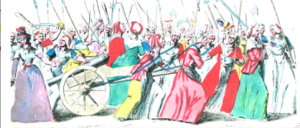
The Many Layers of Women
One of the more fascinating aspects of my research on the French Revolution has been the role that women played in the Revolution. While I’m no historian and have limited knowledge of historical world events, I have never run across such a significant event in which women were the catalysts for such important components. While it’s the men that receive most of the attention (as well as several keynote women such as Marie Antoinette), if you scratch the surface, you’ll find many layers of women whose actions contributed to those turbulent times.
For simplicity sake (at least for my simple mind), I’ve categorized the women into groups: royalty, nobility, citizens (known as sans-culottes), the salons, and the feminists. We can talk about each of these groups but the real forces behind many of the pivotal events of the Revolution were the female citizens of Paris – the working class of Paris or sans-culottes.
Food was scarce. Bread was hard to come by. The weather had taken its toll on the harvests for several consecutive years. It was the woman’s responsibility to feed the family. It was the woman who held her baby who screamed as he slowly died from starvation. These women got mad. They demanded change.
Women Stormed the Bastille Too!
It was the women of the Faubourg Saint-Antoine who joined the men on 14 July 1789 and stormed the Bastille to formally begin the French Revolution.
It was the parade of poissardes – fishwives and market women – who on 5 October 1789 began the 12-mile march in the rain from Paris to Versailles with their pikes, axes, and clubs to demand grain for bread. The next day, after a series of events at the palace, these women forced the royal family back to Paris. The king and queen would never see Versailles again. It was the beginning of the end of the French monarchy.
It was the women citizens from the faubourgs (i.e., suburbs) who fueled the massacres during the first week of September 1792. Who can forget the Tricoteuses, that famous designation given to the women citizens who, each day, would knit in front of the scaffolds as the condemned met their fate?
The burden of taxes, the food shortages, and the hard life under a feudal system fell on the shoulders of the working class families. These women finally had had enough and they were willing to be active participants in the downfall of the ancient régime.
Let’s Hear from You
Do we have a lot of stories? Of course we do. I’m looking forward to sharing these with you. Please continue to visit our blog and perhaps subscribe so that you don’t miss out on the most recent blog posts.
Thanks so much for following my blog and my little journey through this incredibly interesting process of writing a series of niche historical travel books and then getting the bloody things published.
– Stew
Please note that I do not and will not take compensation from individuals or companies I mention or promote in my blog.
Share This:
Follow Stew:
Find Stew’s books on Amazon and iBooks.
Please note that we do not and will not take compensation from individuals or companies mentioned or promoted in the blogs.
Walks Through History
Copyright © 2013 Stew Ross

